Cucumbers are the most popular vegetable plants because you can grow them almost anywhere with the proper care tips. When it comes to growing healthy and tasty cucumbers in numerous amounts, a sufficient amount of fertilization at the right time can make all the difference.
Cucumber plants benefit from regular fertilization throughout the growing season. Apply a balanced fertilizer every 3-4 weeks or use a slow-release fertilizer at the beginning of the season. Avoid over-fertilization, which can lead to excessive vegetative growth and reduced fruit production.
Fertilizing the cucumber plants can be confusing for beginners but becomes easy once you get accustomed to the correct application method. Please read the article till the end to know every detail about the fertilization frequency, type, amount, and right time to apply it.
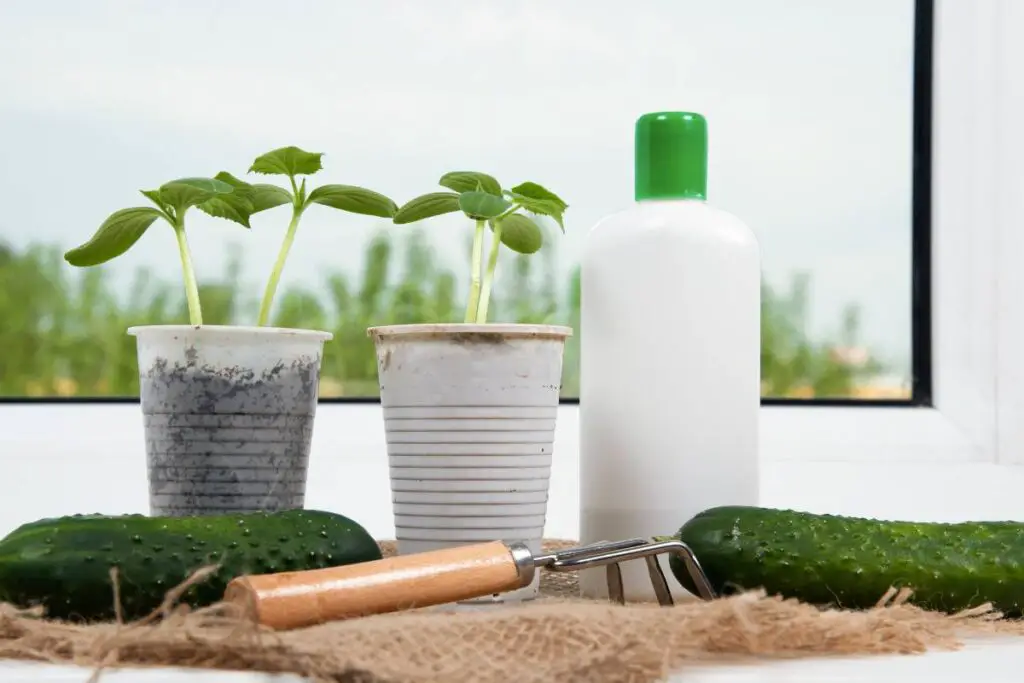
Importance of fertilizing the cucumber plants
As a beginner, I never used fertilizers for my cucumber plants because fertilizers were too complicated.
I assumed that they would survive without it.
They did, but I was never satisfied with the amount of harvest and the time they took to grow and produce cucumbers.
After watching multiple youtube videos, reading various articles, and consulting gardeners at local nurseries, I understood the importance of fertilizing and how it makes a massive difference in the plants’ development.
After that, I never stopped using them.
Cucumber plants need soil that should be well-drained and nutrient-rich.
So, from this, it can be understood why fertilization is essential for them.
Adding fertilizers to the cucumber plants boosts plant growth and encourages fresh and healthy plants.
Also, you receive numerous cucumbers on a single vine.
The fertilizers will give you big, plumpy, and juicy cucumbers.
The optimal frequency of fertilization for the cucumber plants
There is no exact frequency for fertilizing cucumber plants because it depends on your fertilizer.
There are various types of fertilizers for cucumbers.
If you are using slow-release fertilizers, you can apply them once every 1-2 months.
These fertilizers slowly release nutrients to the soil and can stay active for 1-2 months.
As for the liquid fertilizers, you have to apply them weekly or every two weeks.
These fertilizers act quickly and provide plants with immediate nutrients. That is why it gets used up in a few days.
The potted plants need more liquid fertilizers because they get washed away with every watering through the drainage holes.
Water-soluble fertilizers are also used as frequently as liquid fertilizers.
How to determine the right fertilizer amount and when to fertilize cucumber plants?
While using fertilizers, along with frequency and type, the amount of fertilizer is also essential.
Even if you follow the right frequency, the amount of fertilizer is what saves the plant primarily from overfeeding or underfeeding.
Determining the right amount of fertilizer depends on when you fertilize it and what type of fertilizer you use.
The best way to apply fertilizer is, to begin with smaller doses regularly.
Once your plant gets used to it, you can slowly increase it.
Below, I have shared tips about when to fertilize cucumber plants and how to determine the right amount based on that:
Fertilizing during the planting
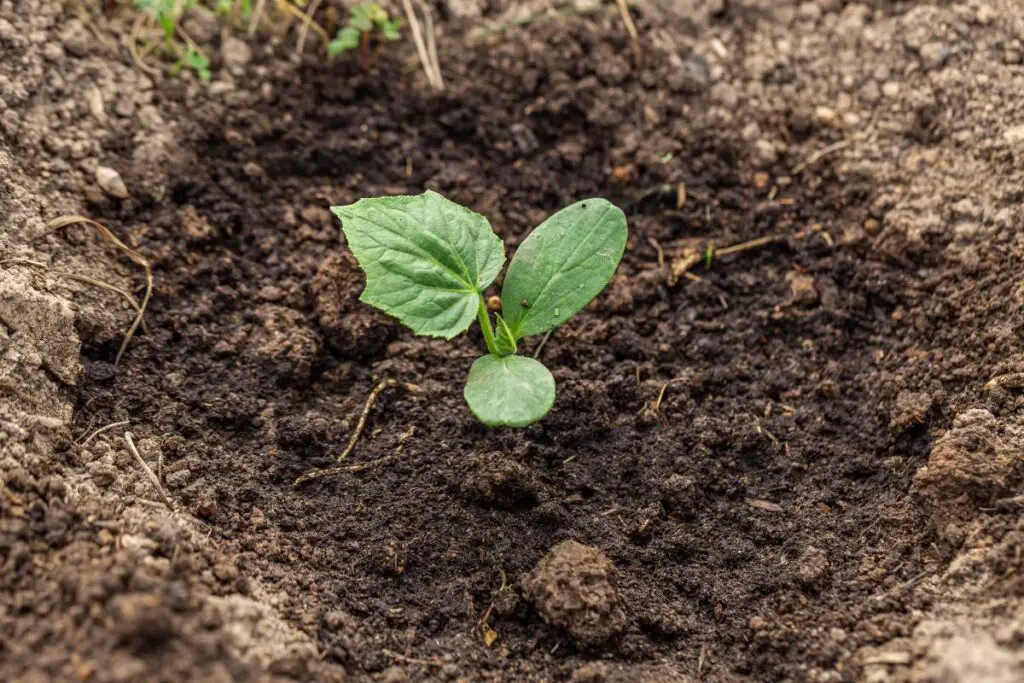
Adding adequate nutrients to the soil before planting encourages faster and healthy growth.
Add 50% of dry organic compost with garden soil to the planting site when planting or transplanting the cucumber seedling.
Compost is a natural fertilizer that will give young plants adequate nutrients.
Add equal parts of garden soil and compost if the cucumbers are in the pots.
For improving drainage, you can also add some vermiculite or sand.
Another way to fertilize is by sprinkling some ammophos before loosening the soil. Add 5 gms of ammophos for 1 m² of the soil bed.
Mulching
Once you have completed planting the cucumber plants in your garden, mulching is essential.
Mulching helps retain moisture and reduce watering to some extent.
Over time, when the mulch breaks down, it will add the necessary nutrients to the soil.
The rule to add fertilizer during mulching is to add organic fertilizers at the base of the plant and then cover it with an inch layer of mulch.
Apply a 2-inch thick layer of compost about 6 inches in diameter.
Now, mix a quarter cult of worm castings into the compost.
Apply regular mulch, like straw, shredded leaves, or sawdust.
The worm castings will work as a slow-release fertilizer every time you water the plant.
When the plant is growing
Once the young plants have increased a few inches, add fertilizers regularly at proper intervals.
If you use liquid or water-soluble fertilizers, add them every 1-2 weeks.
There will be 4 applications. Use a light dose of fertilizer and apply it every 2 weeks for 8 weeks.
I prefer liquid fertilizers for this time because they work by getting absorbed by the leaves and the roots.
They act faster than slow-release fertilizers and encourage healthy growth.
Reduce the fertilizer’s strength by diluting it to make a lighter dose.
If you use a commercial fertilizer, mix it at half strength than recommended on the product’s label.
If the cucumbers are indoors in pots, use a lighter dose, for instance, NPK 2-3-6.
When shifting them outside, increase the dose slightly by 3-6-6.
Use 3 lbs of fertilizer for every 100 square feet.
If you use compost or worm-casting tea, cut it to half the strength by adding more water.
Looking for gardening supplies? We have tested 100's of products before recommending them to you guys. Check out our best pick below:
| Image | Gardening Supplies | Best Price? |
|---|---|---|
 Top
Top Top
Top | Raised Garden Bed Kit | Check On Amazon |
 | XLUX Soil Moisture Meter, Plant Water Monitor, Soil Hygrometer Sensor for Gardening, Farming, Indoor and Outdoor Plants, No Batteries Required | No Results |
 Top
Top Top
Top | 82 Pcs Garden Tools Set and Extra Succulent Tools Set | Check On Amazon |
 | Joeys Garden Expandable Garden Hose with 8 Function Hose Nozzle, Lightweight Anti-Kink Flexible Garden Hoses, Extra Strength Fabric with Double Latex Core, (50 FT, Black) | No Results |
 Top
Top Top
Top | Dual Chamber Compost Tumbler | Check On Amazon |
 Top
Top Top
Top | Sunnyglade Plant Stakes | Check On Amazon |
 Top
Top Top
Top | Organic Cold Pressed Neem Seed Oil | Check On Amazon |
 Top
Top Top
Top | Mighty Mint Gallon :-Insect and Pest Control Peppermint Oil | Check On Amazon |
 Top
Top Top
Top | Scotts DiseaseEx Lawn Fungicide | Check On Amazon |
 Top
Top Top
Top | Jacks Classic 20-20-20 All Purpose Fertilizer | Check On Amazon |
 Top
Top Top
Top | 30,000 Seeds Pollinator Attracting Wildflower Mixture | Check On Amazon |
 Top
Top Top
Top | Survival Vegetable Seeds Garden Kit-Over 16,000 Seeds | Check On Amazon |
At the beginning of the flowering
When the flowering period starts, dissolve 40 gms of superphosphate, 20 gms of potassium nitrate, and 30 gms of ammonium nitrate in a bucket of water.
Use this solution to water the plant base in the soil to help it reach the roots.
The landscapes with multiple cucumber plants will benefit from this method the most.
While active fruiting
Fill up a bucket half with manure and pour it to the brim with water and let it stay at a warm place for 7 to 10 days.
Use this solution to water the plant at the roots once a week. It is ideal for cucumbers growing in bulk in open ground.
When to back off fertilizing?
When your cucumber plants start growing fully, it is time to reduce fertilizing and concentrate on harvesting.
Once the plant is filled with flowers and fruits, stop fertilizing.
Remember to harvest the cucumbers in time. Otherwise, you will suffer from fruit overload, i.e., too many ripe fruits.
Feed the plant again when you suspend the fruit growth to activate another crop wave.
Dissolve 3 scoops of Agronom Pro for Cucumbers in one bucket of water.
Water the plant with this solution at the roots once every 2 weeks.
Types of fertilizers
Some fertilizers, especially those best for the cucumber plants, will have mentioned CUCUMBER FERTILIZERS on the label.
For cucumbers, there are four types of fertilizers to use:
Granular fertilizers
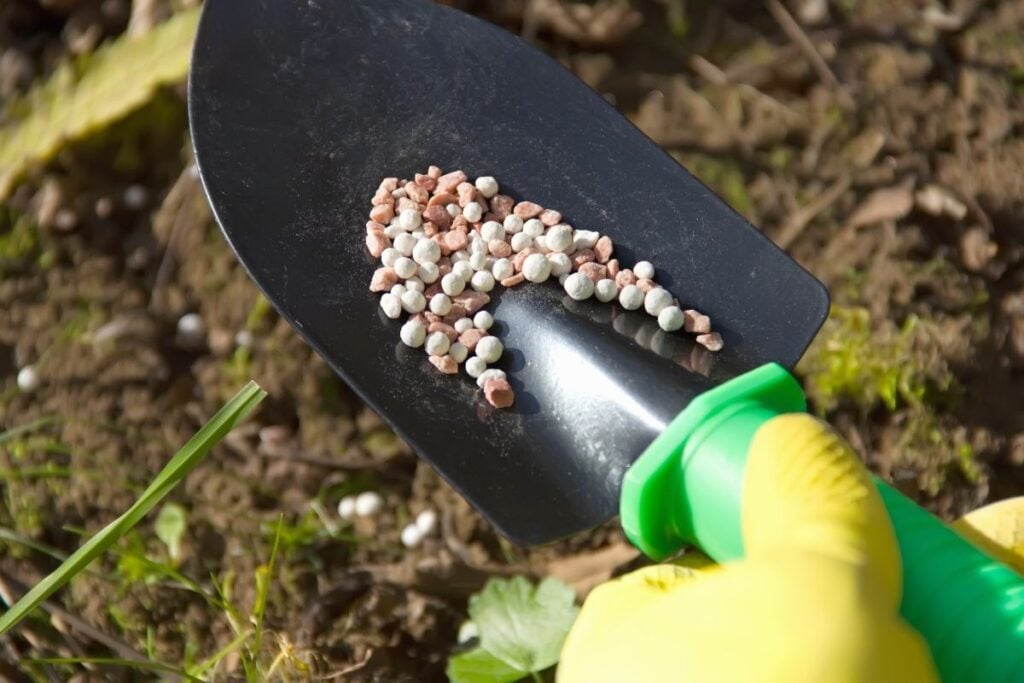
These are time-release fertilizers available in tiny pellets.
Since they are slow-release, they gradually discharge the nutrients to the soil and feed the plant for several weeks.
That is why you must use them only once every 1-2 months.
Mix the granules in the top 1-2 inches of the soil and water the plant to activate them.
Slowly they will dissolve and release nutrients into the soil.
Spikes
Spikes are another slow-release type of fertilizer in tablet form.
Spikes consist of dry nutrients pressed into hard cylinders.
Push the spike into the soil surface and water the plant to activate it.
Slowly, the spikes will dissolve and release the nutrients over the months.
Once, I used spikes and was amazed by the results.
Spikes are the best type of fertilizers for cucumbers grown in pots because they provide nutrients constantly, even in that limited amount of soil.
Liquid fertilizers
Liquid fertilizers are available in a concentrated form to get mixed with water or as a ready-to-spray fertilizer for foliar feeding.
The liquid fertilizers get instantly absorbed by the plant. But it will also wash away every time you water the plant.
So, frequently add this fertilizer, like every 1-2 weeks. I use these fertilizers every 2 weeks for my cucumber plants.
Water-soluble fertilizers
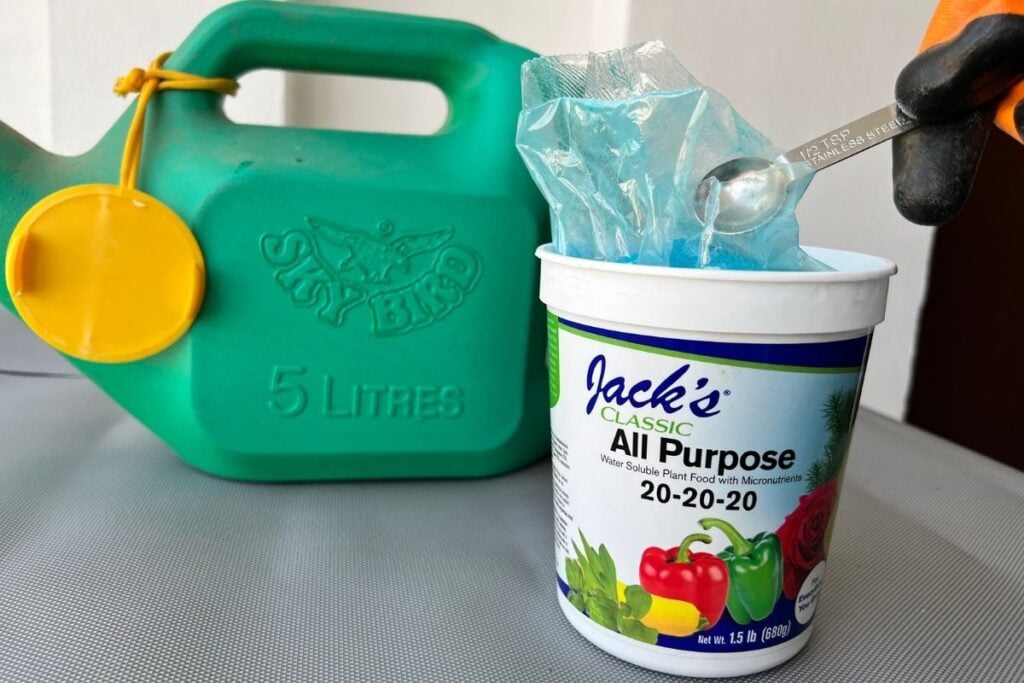
These fertilizers are available in powder form or fine granules.
You need to dissolve this into the water like liquid fertilizers and then apply it to the plants.
Like liquid fertilizers, it acts quickly. Therefore, it must be applied weekly.
Organic vs. Inorganic fertilizers
Some fertilizers for the cucumber plants are organic, and others are inorganic.
As long as the cucumber’s requirements are fulfilled, all types of fertilizers are ideal for its growth, whether organic or inorganic.
The ingredients present in organic fertilizers are taken from nature. Some suitable organic fertilizers include:
- Worm casting
- Compost manure
- Bone meal
- Sea meal
- Neem or Mustard cake
These fertilizers do not contain any impurities or chemicals.
Organic fertilizers easily get absorbed by plants.
But you won’t be able to see any dramatic progress in your plants like the inorganic products give.
On the contrary, inorganic or commercial fertilizers contain synthetic ingredients.
But it will still encourage the cucumber plants to produce healthy and tasty cucumbers.
Inorganic fertilizers will help the plant to boost plant growth and increase the harvest.
Inorganic fertilizers are more affordable than organic fertilizers because of their manufacturing process.
Some commercial fertilizers include:
- Greenway Biotech Cucumber fertilizer
- Espoma Organic Garden-tone Herbs & Vegetable food
- Down to Earth Organic Vegetable Garden Fertilizer 4-4-4
- Miracle-Gro Shake’N Feed Vegetable Food 10-15-15
- Foxfarm Big Bloom Liquid Plant Food
Though both are fine for the cucumbers, people prefer organic fertilizers over inorganic because the latter contain chemicals that may be hazardous for houses with kids and pets. I have used both.
Nutrient requirements
Cucumbers have less demand for nitrogen and a high demand for potassium and phosphorus.
Nitrogen helps in green growth. But we need cucumbers and not any leafy greens.
So, when you feed your plants with fertilizers, check the label for these three nutrient content.
Feeding the cucumbers with high nitrogen content will lead to excessive leaf growth and no vegetables.
The flowers developing in the plant won’t open, reducing the chances of cucumber growth.
The right type of fertilizer based on the nutrient level should contain an NPK value of 5-8-10 or 3-3-3.
Since these have low nitrogen, they will work fine with the cucumber plants.
You can also use a balanced fertilizer with 10-10-10 NPK if the plant thrives in the ground.
Nitrogen, phosphorus, and potassium are the macronutrients needed by all plants.
Along with these, the cucumbers will also need the micronutrients, like:
- Iron
- Calcium
- Magnesium
- Manganese
- Iron
Now, what is this NPK?
NPK stands for Nitrogen (N), Phosphorus (P), and Potassium (K).
All the fertilizers contain an NPK ratio, and you choose the right one by seeing these NPK values.
When a fertilizer says it contains an NPK value of 3-4-6, it will have 3% nitrogen, 4% phosphorus, and 6% potassium.
The remaining will be the micronutrients.
Potted cucumbers grow best in a lower NPK rating, for example, NPK 2-3-6.
For the landscape cucumbers, use fertilizers containing an NPK value of 5-10-10 or a balanced liquid fertilizer with a 20-20-20 value.
Signs of nutrient deficiency
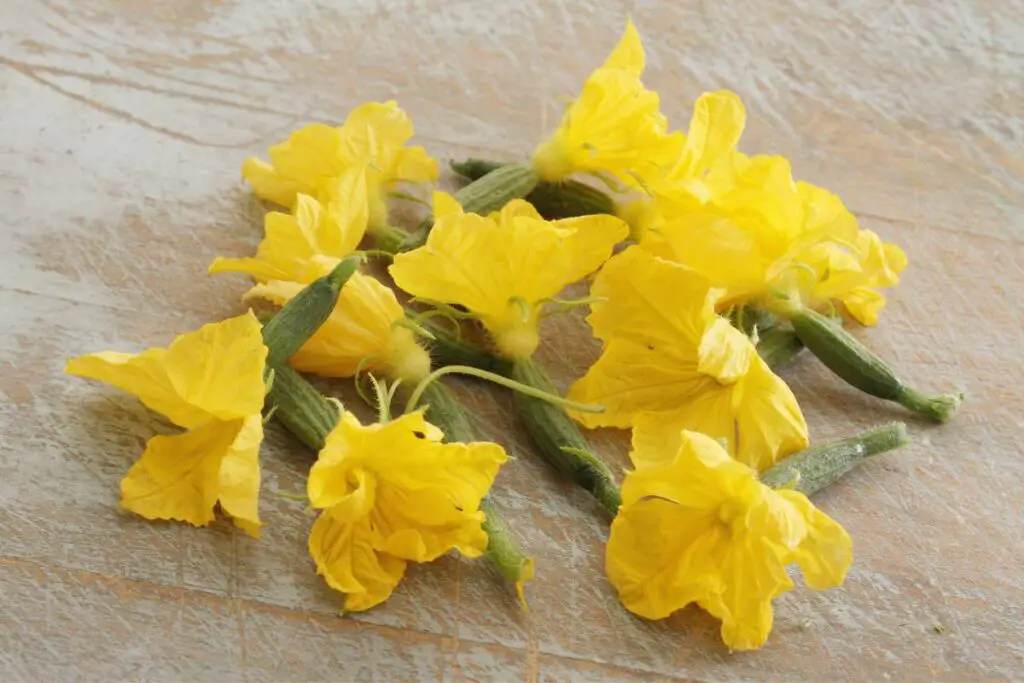
Cucumber plants are heavy feeders. Not fertilizing them can lead to slow growth and less harvest.
When cucumber plants do not receive enough nutrients, they will display some significant symptoms:
- Yellow leaves
- Wilted leaves
- Stunted growth
- Less yield
- Dropping of flower buds
These could also be signs of the wrong soil or inadequate sunlight.
Fertilization deficiency is the common one.
When you do not take care of the plant, your plant will grow weak with fewer or small leaves and zero yields.
To fix the nutrient deficiency, start fertilizing your plant immediately.
Begin with some organic fertilizers, like compost.
Once your plants have recovered, apply liquid fertilizers every 2 weeks.
The plant will immediately receive enough nutrients, become healthy, and produce enough cucumbers.
How to protect the cucumber plants from excessive fertilization?
When you see that your plant will do great with fertilizers, it becomes tempting to add more fertilizers.
When I learned how fertilizing increases the plant’s health and cucumber growth, I was too excited and started using them frequently.
But suddenly, I started noticing yellowing and defoliation.
I ignored it initially, but when it increased, I was confused as I used to provide the correct care guide.
When I told one of my friends (she’s also a plant parent) about the plant’s reaction and the care I provide, she told me that I had overfertilized it.
So, if you are unaware of the situation, the following symptoms will help you identify the problem :
- Yellow and wilted leaves at the lower part of the plant
- Stunted growth
- Defoliation
- Brown leaf edges and tips
- White crusts over the soil surface
Excessive fertilization interrupts the plant’s moisture and nutrient absorption, for which the leaves change color and fall off.
Moreover, excessive fertilizers leave mineral salts on the surface and burn the leaves, creating white crusts and brown edges.
If you do not want to make the mistake I have made by over-fertilizing my plants, follow the following steps to protect your plant whenever you notice signs of overfeeding:
- Water the soil thoroughly to remove the white crusts from the soil.
- If your plant is in the pot, flush your pot correctly. Water the plant thoroughly and let the water drain out. Again, water the plant after some time.
- Stop fertilizing your plant for a few weeks and see whether your plant is reviving or not.
- Give your plant enough water and sunlight. Make sure not to overdo anything.
- Whenever you use fertilizer, be careful about the amount and frequency.
- Try to use organic fertilizers for better results.
Tips for fertilizing the cucumber plants
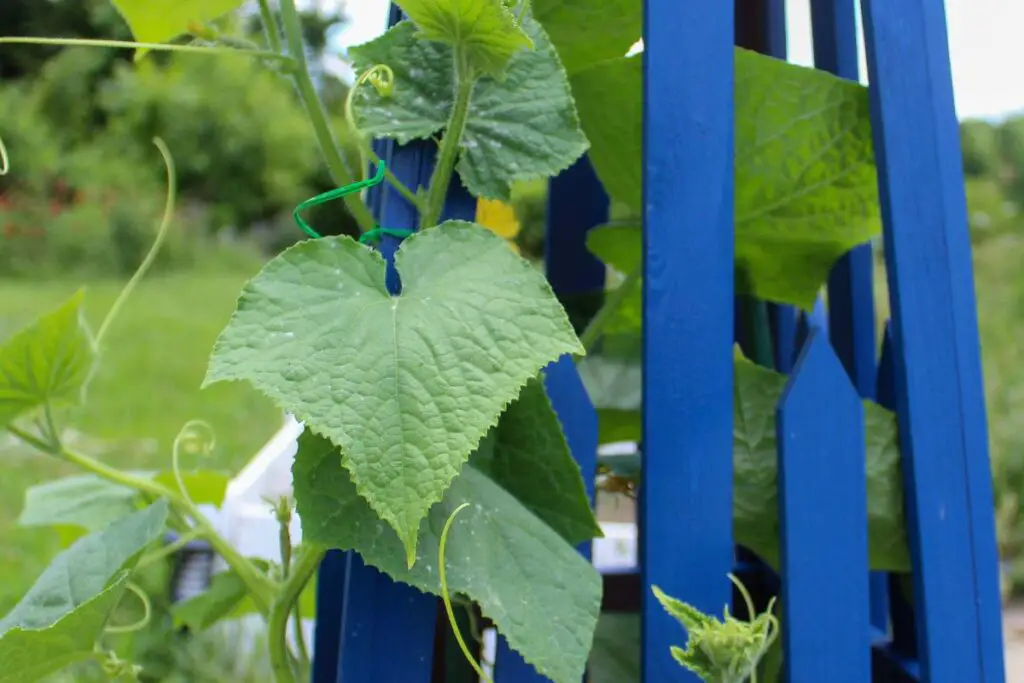
Fertilizing does not need any expert’s help. You can quickly learn it with some expert guidance.
Here are some tips for fertilizing the cucumber plants properly:
- Use the correct type of fertilizer. Always go low in nitrogen and high in phosphorus and potassium. Begin with a lower NPK rating or opt for organic fertilizers.
- Though you need to fertilize the plants at their several growth stages, the right time to fertilize is in their growing season, i.e., summer. As the weather gets cooler, stop fertilizing them.
- The best time to fertilize the cucumber plants is in the early morning or evening when the sunlight is less intense. This way, you can prevent leaf burns.
- Avoid applying fertilizers directly to the dry soil. Water your plant before fertilizing. It dilutes fertilizers, reduces the dose, and prevents root burns.
- Avoid applying fertilizers to the leaves directly, as that will burn the leaves. If you must apply it to the leaves, dilute it with adequate water and use it as a foliar spray.
- Use the right amount of fertilizers. Though I have shared some suggestions, the best way is to follow the instructions mentioned on the product labels. Reduce the dose by keeping the strength half the label’s recommended amount.
- Apply the fertilizer evenly around the soil. After applying, water the plant thoroughly to activate and spread the nutrients evenly.
- Though you can use both organic and inorganic fertilizers, it is better to use organic products. They are natural and do not contain any impurities.
How to adjust the fertilization for cucumber plants grown in different soil types?
The best type of soil for cucumber plants is well-drained and nutrient-rich soil with a pH level between 6 and 6.5.
If the soil type doesn’t have these features, you have to adjust the soil and then fertilize it.
Below are different soil types and how to adjust the fertilization accordingly:
- If the soil is loamy, everything is perfect; drainage, retention, and nutrients. So, use a balanced liquid fertilizer every 1-2 weeks.
- Sandy soil cannot hold moisture and nutrients for long. So, if your cucumbers are growing in sandy soil, fertilize them more frequently to give them adequate nutrients. Or, add compost to improve retention and add essential nutrients to the soil.
- Clay soil can hold nutrients but has poor drainage. So, it holds the nutrients for too long, leading to over-fertilization. Adjust it by mending the soil with materials high in drainage properties, for example, sand, perlite, or vermiculite. Or, use a slow-release fertilizer to let the nutrients release slowly over the months.
- Adjust the pH before fertilizing when the soil becomes too acidic or alkaline.
Final thoughts
Fertilization can be tricky when you are a beginner at growing cucumbers. But once you gather sufficient information and guidance, it is easy. Fertilize every 1-2 weeks with a liquid fertilizer or every 1-2 months with a time-release fertilizer. You can fertilize the plant before planting, during mulching, and when the plant starts growing.
Besides these, you can also feed the plant at the beginning of the flowering and when the plant is actively fruiting. You can use both organic and inorganic fertilizers as long as their requirements are fulfilled. Cucumbers need low nitrogen and high potassium and phosphorus. So, choose the fertilizers wisely.
The best option is a lower dose with NPK 2-3-6 or 3-6-6. You can also use a balanced fertilizer with NPK 3-3-3 or 10-10-10 for landscapes. Check for signs of over-fertilizing and under-fertilizing and treat them as required. Follow the fertilization tips for successful and healthy outcomes.
Are coffee grounds ideal for cucumber plants?
Coffee grounds can benefit the cucumber plants, provided you use them in smaller amounts. During the seed stage, cucumbers can attract pests. Add only 5% of coffee grounds to the compost mixture to prevent pests and mildew.
Will the bone meal be ideal for the cucumbers?
Bone meals can provide sufficient phosphorus and help in good growth and development. Add it once the flowers set in to encourage large and plumpy cucumbers.
Reference: Cucumber Wikipedia


I’m confused about fertilizing when the cucumber sets flowers and is fruiting. At one point didn’t you say to stop but then I read you do still fertilize. What is correct?
Thank you
I apologize for any confusion. When it comes to fertilizing cucumbers, it is important to adjust your fertilization schedule based on the growth stage of the plant.
During the early stages of growth, it is beneficial to fertilize the cucumber plants regularly to encourage healthy growth and development. However, once the plants start to set flowers and fruit, it is important to reduce the frequency of fertilization and adjust the type of fertilizer you use.
At this stage, you can switch to a fertilizer that is lower in nitrogen and higher in phosphorus and potassium, as these nutrients are important for flower and fruit development. You can continue to fertilize the plants once every 2-3 weeks, but be sure to use a balanced fertilizer with an NPK ratio of around 5-10-10.
It is also important to avoid over-fertilizing, as this can lead to excessive vegetative growth at the expense of flower and fruit development. Be sure to follow the instructions on the fertilizer package carefully and avoid applying too much fertilizer at once.